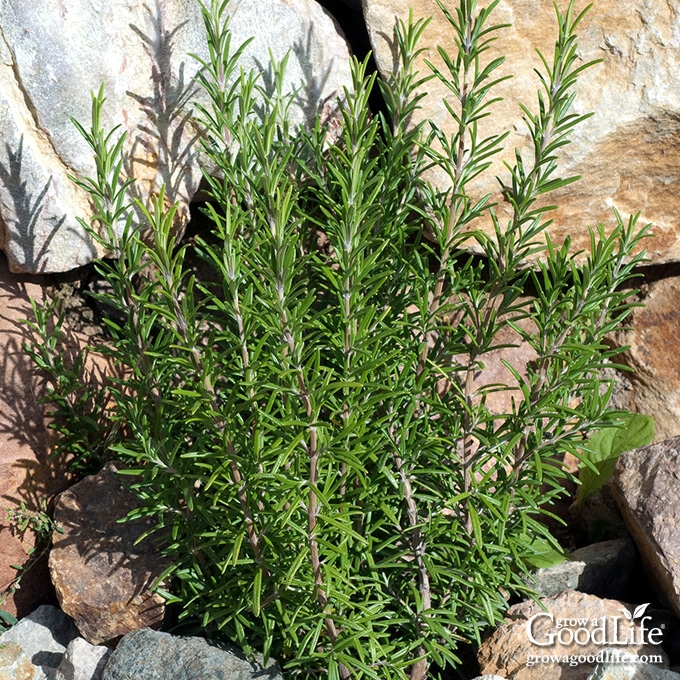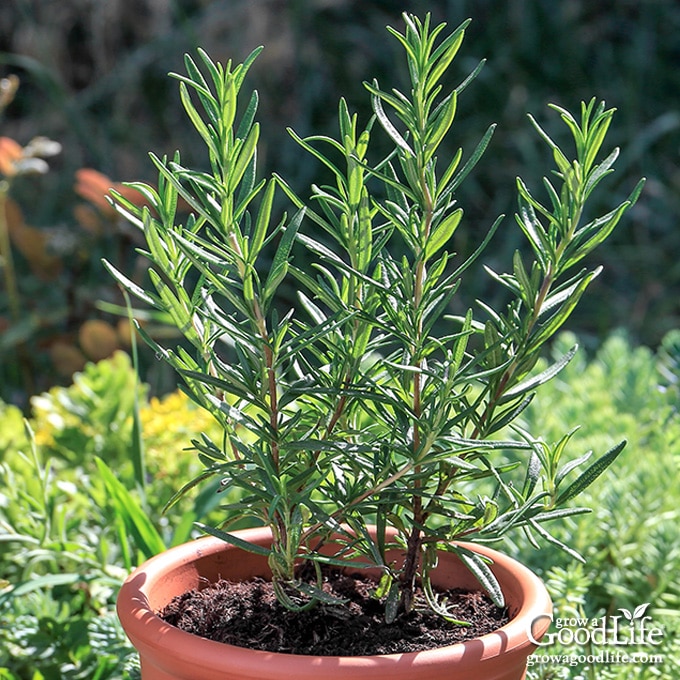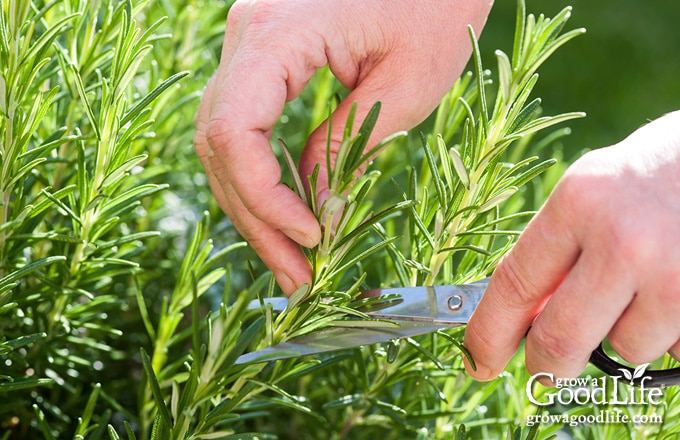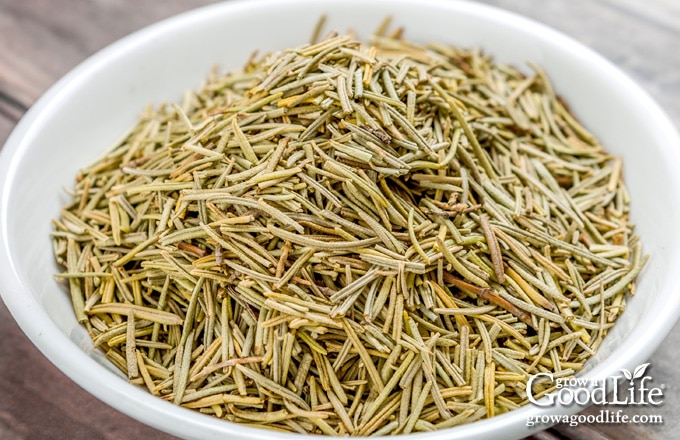How to Grow Rosemary
This post may contain affiliate links, which means that I may receive a commission if you make a purchase using these links. As an Amazon Associate I earn from qualifying purchases.
Rosemary is one of the most popular herbs you will find in anyone’s spice cabinet, and now you can have it fresh from your garden! Read on for tips and tricks on how to grow rosemary.

Fragrant, bold, and classic, rosemary is a timeless herb that graces just about everyone’s kitchen. This versatile herb can be used in many recipes, from roasted vegetables and meats, simmered in soups, pureed into dips, baked in bread, and chopped to add flavor to tomato sauce.
Everyone knows rosemary is an aromatic, delicious herb, and you may not know how easy it is to grow and care for rosemary plants. This growing guide will give detailed instructions for planting, growing, and caring for this classic culinary herb!
About Rosemary
Rosemary (Salvia Rosmarinus) is a perennial evergreen shrub that is native to the coast of the Mediterranean Sea. The genus name Rosmarinus comes from the Latin words ros and marinus, which mean “dew of the sea.” Rosemary has been used as a culinary herb since the time of the early Greeks and Romans. Since then, rosemary has spread far and wide and has earned its place in our spice cabinets.
Rosemary is identifiable by its narrow, needle-like leaves that grow on upright, woody stems. While often grown for culinary purposes, the shrub is attractive enough to include in your flower garden or landscape design. During its second growing season, rosemary produces small light blue, pink, purple, or white flowers that attract pollinators in late spring and early summer.
As a native of the Mediterranean region, rosemary enjoys warm, fairly humid conditions. Under similar growing conditions, rosemary can develop quite vigorously when left on its own, so a good pruning regiment is necessary.
If you live in USDA zone 8 or higher climate, rosemary can be left outdoors all year long and grown as a perennial. However, cooler zones should keep their rosemary in a pot and bring them indoors when the weather gets too cold.

Rosemary Varieties
There are many different cultivars of rosemary. Some have an upright bush shape, while others are prostrate types that grow horizontally and are often used as ground covers. Most varieties are hardy for USDA zones 8 to 10, with winter temperatures as low as 10˚F. The exceptions are Arp, Hill Hardy, and Salem, which are even more cold-hardy.
- Arp Rosemary is an upright, sturdy shrub that can grow up to 5 feet tall and 3 feet wide. It is more cold-hardy than other varieties, can tolerate temperatures down to -10˚F, and may survive winters in zone 6.
- Hill Hardy Rosemary, also called Madalene Hill, is the second most cold-hardy variety, produces dense, bright green foliage, and can grow 5 feet tall and wide. Hardy to temperatures around 0˚F and may tolerate winters in USDA hardiness zone 7.
- Salem Rosemary, also called Bushy Blue, has an upright growth that can reach about 3 feet tall and wide. The blossoms are a deep blue-violet color. Salem is relatively tolerant of wet soil, unlike other varieties, making it ideal for high-humidity growing locations and containers. In addition, it is hardy to temperatures around 5˚F and can survive winters in zones 7.
- Tuscan Blue Rosemary has a rapid, upright growth that can reach 6 feet tall. The leaves are wider than other varieties, the stems have a red tinge, and the plants produce deep blue flowers. Tuscan Blue is hardy to 15˚F.
- Prostratus Rosemary has a low growing, spreading growth habit and will reach about 2 feet high and wide. The branches will drape and trail around the pot when growing in a container. Prostratus is ideal for slopes, rock gardens, or container gardens.
Tips for Growing Rosemary
Rosemary is a versatile herb you can plant in containers or your herb or vegetable garden. Depending on the variety, rosemary is winter hardy, surviving temperatures to about 20˚F with little human intervention. I recommend growing rosemary in the ground if you live in growing zone 8 and above.
However, rosemary plants may die in the cold winters in zones 7 and below. For these zones, you can grow rosemary as an annual or in a container you can bring indoors to overwinter.
Rosemary is a slow-growing plant. However, if you’re in a time crunch and need to plant rosemary fast, your local garden nursery will surely have rosemary seedlings that you can immediately plant in your garden.
While the quickest way to enjoy rosemary harvests is to transplant good-sized seedlings, growing rosemary from seeds and propagating from stem cuttings can be rewarding. Here are tips for growing rosemary:
Garden Site Selection and Preparation
If you are growing rosemary in the garden, choose an area with plenty of sunlight and well-draining soil. Rosemary grows best with a soil pH that is slightly acidic to neutral, around 6.0 to 7.0.
As a plant native to the coastal regions of the Mediterranean, rosemary bushes thrive in full sun. Your site selection should sustain at least 8 hours of sunlight per day. Avoid placing your rosemary in a shady location near tall trees.
Well-draining soil is one of the keys to maintaining a healthy rosemary plant. Heavy, compacted soil tends to trap moisture and could cause the roots to rot. Rosemary plants prefer soil that is evenly moist but not soggy.
When selecting a location, remember that rosemary can grow quite large in warm areas, sometimes up to 4 feet tall and 4 feet wide, depending on the variety. So be sure the place you plant it can accommodate a large bush.
How to Start Rosemary from Seed
While it is possible to grow rosemary from seeds, please remember that it has a low germination rate and can take up to 3 years to grow into a large enough plant for harvesting.
If you are up for the challenge, start with fresh seeds, and sow many at once, increasing the likelihood that a few seeds will sprout. Then, start seeds indoors 3 months before your last spring frost date. You can find your last frost date by contacting your local extension office (search for “extension office near me”) or enter your zip code here at PlantMaps.com.
Fill your seedling containers with damp seed starting mix to within 1/2-inch of the top of the container. Heavily sow seeds on top of the soil and then cover them with a light dusting of potting mix.
Cover the seed containers with a humidity dome to retain moisture. Next, place the seed tray on a seedling heat mat to maintain a soil temperature between 80° to 90° F. Keep in mind that rosemary seeds can take up to 3 weeks to germinate, so don’t feel discouraged if weeks have passed, and there’s no sign of sprouting.
When sprouts begin to appear, remove the seedlings from the heat mat, and place them under lights for 16 hours per day. Once the plants are at least 3 inches tall, transplant them into the ground or a pot. Learn more about starting plants from seeds indoors: 10 Steps to Sowing Seeds Indoors.
Propagating Rosemary from Cuttings
Growing rosemary from stem cuttings is much quicker than starting from seed. You can propagate rosemary by taking stem clippings from a healthy plant, removing lower leaves, and rooting them in water or soil using a rooting hormone. Once the plants form roots, plant in a well-draining potting mix in trays or pots and water regularly until the plants become established.
Once the plants are 3 inches tall, you can transplant them into the ground or in a larger container. Learn how to root rosemary cuttings and grow new plants with this step-by-step tutorial: How to Propagate Rosemary from Stem Cuttings.
Transplanting Seedlings
If you are planting seedlings purchased from a nursery, wait to transplant them until after your last frost date, and be sure to harden them off before planting.
Choose a cloudy day with no wind and transplant in the late afternoon or evening to give your plants time to adjust without the additional challenge of the sun.
Dig a deep hole to contain the root ball at the same level as the original container. Add about 4-inches of finished compost and mix into the soil. Squeeze the container around the edges, remove the plant, and loosen the roots at the bottom.
Center the plant in the hole, and then gently firm in with the soil. Water well, and keep moderately moist until the plant becomes established.
Growing Rosemary in Containers
If you’re growing rosemary in a pot, choose a well-draining potting mix or a succulent or cactus soil that contains plenty of perlite, coarse sand, and pumice. You can mix your own growing medium by combining 3 parts potting soil, 3 parts coarse horticultural sand, and 2 parts perlite or pumice. Then, mix in an all-purpose, slow-release fertilizer according to the manufacturers’ directions.
Avoid planting rosemary in moisture control potting mixes with lots of peat moss or ones with added fertilizer. These usually hold too much moisture for rosemary, which can cause the roots to rot.
Clay or terracotta pots are ideal for growing rosemary because they are porous and let the potting soil dry out more evenly in between watering. Choose a container that will provide an additional 2-inches or more between the root ball, sides, and bottom. There should be adequate holes in the bottom of your pot for drainage. Drill more if needed.
Then, fill the bottom of the container with damp potting mix. Remove the rosemary from the pot, and loosen the roots at the bottom. Center the plant into the new container, and fill the sides with potting mix. Water well, and place the plant in an area out of the direct sun for a few days so it can adjust to the new environment.
Make sure to repot your plant every year to allow your plant to grow comfortably. The best time to repot is at the beginning of the growing season in spring. Then, over the years, gradually move your rosemary to a pot that is the next size up.

Overwintering Rosemary
Rosemary is a perennial, meaning it can survive several growing seasons if treated correctly. If you live in gardening zones 7 and below, the plants will freeze and die during the winter. However, you can overwinter the plants indoors so they will survive to grow again next year.
Plant your rosemary in a container, and bring your pots into the house for winter. This should be done before the first fall frost date. You can learn more about maintaining an indoor herb garden in this article: How to Grow Herbs Indoors.
If you have houseplants, it is a good idea to quarantine your rosemary plants when you bring them indoors. Keep the plants isolated for a little while to be sure there are no pests.
Your rosemary plants need to stay in a location where the air temperature is warm, but not dry. If your home air tends to be on the dry side, then I suggest looking into an air humidifier or plant mister to keep the air humid and your rosemary healthy. Lighten up on watering your rosemary plants while they overwinter. While you should cut back on watering, it is still important to make sure their soil doesn’t dry up.
Overwintered rosemary plants still require a full day’s worth of sunlight. This can be achieved by placing your rosemary in a bright, sunny location in the home, such as a south-facing window. You can also use grow lights to supplement the rosemary’s sun requirement.
Your rosemary plants can safely be returned to the outdoors in the springtime when all threats of frost have passed.
How to Care for Rosemary Plants
Rosemary is pretty easy to grow, but it does need some care, especially in the beginning. Here are a few tips to keep your rosemary plants healthy and thriving:
Water As Needed
Rosemary is a very drought-tolerant plant that can survive in dry soils. It doesn’t require much water to grow in pots or planted in the garden. Let the soil dry out between watering, and rosemary will be fine.
Water a new plant regularly to keep the soil slightly moist until it becomes established and shows new growth. Then, you can let the soil surface dry out in between watering.
Water the plants as needed, especially during periods of drought. Use your finger to check moisture levels. If the soil feels dry about two inches deep, then it’s safe to hydrate your plants.
Fertilize Sparingly
Rosemary plants are not heavy feeders and don’t require a fertilizer routine. However, you can provide your rosemary with enough sustenance by adding organic compost into their potting soil at the time of planting and then side-dress with additional fertilizer in early spring.
Additionally, if the plant seems to be struggling with slow growth, or pale foliage, you can water it with a balanced liquid fertilizer, such as fish emulsion, to encourage growth.
Prune Frequently
Rosemary is a vigorous grower, so make sure to give it a good pruning every once in a while. Untrimmed rosemary tends to grow long, leggy branches. Cutting the stem will cause it to split and grow two branches that will fill out the plant. By pruning, you’re benefiting the plant by encouraging fuller, bushier growth.
You can prune anytime from spring to late summer. Shape the plant by cutting off one to two inches of the branches. Make sure to trim any foliage that appears to be dead or damaged, and remove any spent flowers. Save the healthy cuttings for your spice cabinet.
Watch for Pests and Diseases
Rosemary’s scent keeps most pests away, but you may occasionally find aphids, spider mites, mealybugs, or scales on indoor and outdoor plants. You can control these by trimming the affected branches or with organic insecticidal soap.
Fungal diseases that may affect rosemary are downy mildew, powdery mildew, root rot, and crown rot. These are caused mainly by overwatering and can be controlled by reducing the moisture the plant is receiving. Make sure to provide good air circulation and avoid overwatering.
When and How to Harvest
You can harvest sprigs of rosemary at any time. However, keep in mind that spring and summer are the best times to harvest because that’s when the rosemary plant is in active growth. While all rosemary stems are delicious, select younger new shoots for the freshest flavor. Rosemary is also most flavorful just before flowering in early spring.
To harvest rosemary:
- Use pruners or scissors and cut off 4-inch stem tips.
- Gather in the morning once the dew has evaporated from the foliage.
- Snip as needed for recipes, or harvest a bunch at once for preserving.
- Only harvest up to 1/3 of the rosemary plant at a time, or it may stunt the plant.
- Give your plant time to regrow before harvesting again.
Rosemary can be used fresh in recipes, or it can be dried and used at a later date. Store fresh rosemary in the refrigerator and use it within a week.

How to Dry Rosemary
You can air-dry rosemary or use a food dehydrator. To air dry, hang the stems upside down in a cool, well-ventilated area. It takes roughly two weeks for the foliage to be thoroughly dried.
To dry using a food dehydrator, place the rosemary in a single layer onto the dehydrator trays and dry at the lowest temperature, around 95˚F. It takes about 8 to 12 hours for rosemary to dry in a dehydrator.
After the stems are dehydrated, strip off the leaves, and store them in an airtight container. Use dried rosemary within a year or two for the most potent flavor. Learn more about preserving herbs in this article: How to Dry Herbs for Food Storage.

Rosemary is indeed a unique herb. But even though it’s unusual, it’s still easy to grow. So with these simple tips, we hope your rosemary plant will stay happy and healthy for many years!
You May Also Like the Following:
- 7 Easy Herbs to Start from Seed
- 13 Herbs that Grow in Partial Shade
- How to Grow Herbs Indoors
- How to Grow Basil
- How to Grow Thyme
Good planning is key to a successful vegetable garden
Whether you are new to growing your own food or have been growing a vegetable garden for years, you will benefit from some planning each year. You will find everything you need to organize and plan your vegetable garden in my PDF eBook, Grow a Good Life Guide to Planning Your Vegetable Garden.

